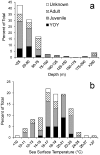Seasonal distribution and historic trends in abundance of white sharks, Carcharodon carcharias, in the western North Atlantic Ocean
- PMID: 24918579
- PMCID: PMC4053410
- DOI: 10.1371/journal.pone.0099240
Seasonal distribution and historic trends in abundance of white sharks, Carcharodon carcharias, in the western North Atlantic Ocean
Abstract
Despite recent advances in field research on white sharks (Carcharodon carcharias) in several regions around the world, opportunistic capture and sighting records remain the primary source of information on this species in the northwest Atlantic Ocean (NWA). Previous studies using limited datasets have suggested a precipitous decline in the abundance of white sharks from this region, but considerable uncertainty in these studies warrants additional investigation. This study builds upon previously published data combined with recent unpublished records and presents a synthesis of 649 confirmed white shark records from the NWA compiled over a 210-year period (1800-2010), resulting in the largest white shark dataset yet compiled from this region. These comprehensive records were used to update our understanding of their seasonal distribution, relative abundance trends, habitat use, and fisheries interactions. All life stages were present in continental shelf waters year-round, but median latitude of white shark occurrence varied seasonally. White sharks primarily occurred between Massachusetts and New Jersey during summer and off Florida during winter, with broad distribution along the coast during spring and fall. The majority of fishing gear interactions occurred with rod and reel, longline, and gillnet gears. Historic abundance trends from multiple sources support a significant decline in white shark abundance in the 1970s and 1980s, but there have been apparent increases in abundance since the 1990s when a variety of conservation measures were implemented. Though the white shark's inherent vulnerability to exploitation warrants continued protections, our results suggest a more optimistic outlook for the recovery of this iconic predator in the Atlantic.
Conflict of interest statement
Figures











References
-
- Compagno LJV (2001) Sharks of the world: an annotated and illustrated catalogue of shark species known to date. Vol. 2. Bullhead, mackerel, and carpet sharks (Heterodontiformes, Lamniformes and Orectolobiformes). FAO Species Catalogue for Fishery Purposes, No. 1, Vol. 2. Rome, FAO. 269 pp.
-
- Cortés E (1999) Standardized diet compositions and trophic levels of sharks. ICES J Mar Sci 56: 707–717.
-
- Estrada JA, Rice AN, Natanson LJ, Skomal GB (2006) Use of isotopic analysis of vertebrae in reconstructing ontogenetic feeding ecology in white sharks. Ecol 87(4): 829–834. - PubMed
-
- Smith SE, Au DW, Show C (1998) Intrinsic rebound potentials of 26 species of Pacific sharks. Mar Freshw Res 49: 663–678.
-
- Cortés E (2002) Incorporating uncertainty into demographic modeling: Application to shark populations and their conservation. Conserv Biol 16(4): 1048–1062.
MeSH terms
LinkOut - more resources
Full Text Sources
Other Literature Sources

